Josef Maria Auchentaller
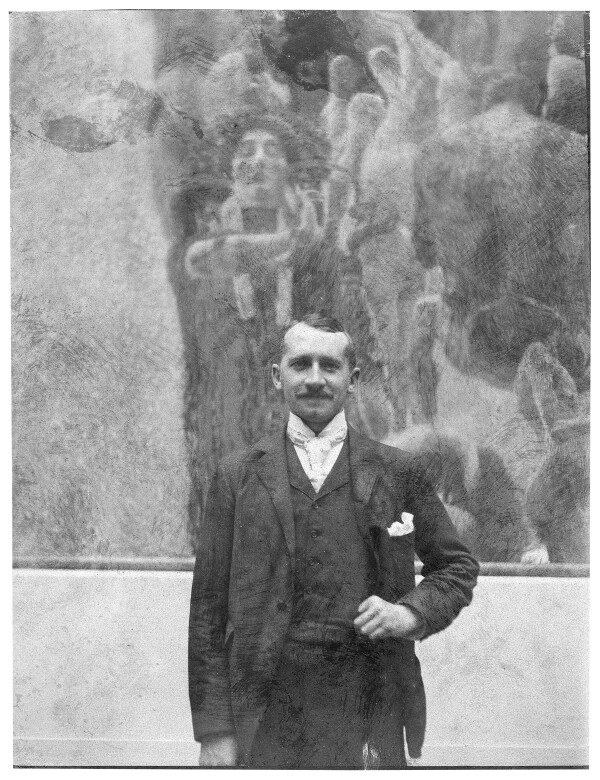
Hans Watzek (?): The medicine, presumably June 1901 - October 1901, private collection: Josef Maria Auchentaller in front of Gustav Klimt’s Medicine at the “VIII. Internationale Kunstausstellung im königlichen Glaspalast zu München,” 1901, private collection
© Anonymous
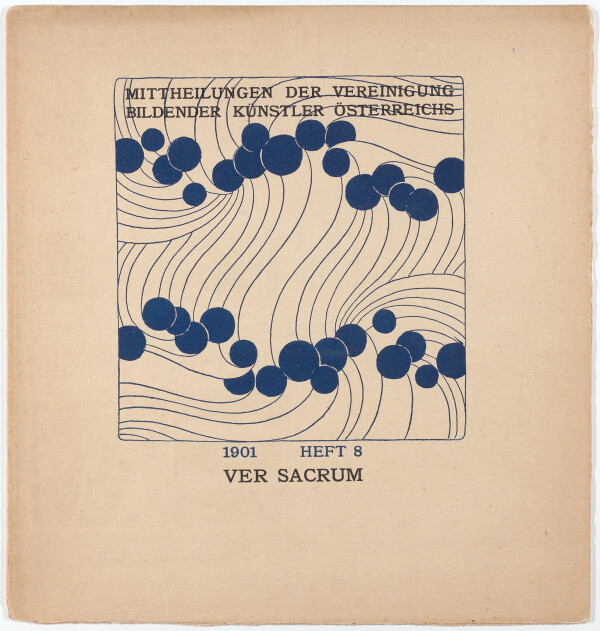
Title page, in: Vereinigung bildender KünstlerInnen Wiener Secession (Hg.): Ver Sacrum. Mitteilungen der Vereinigung bildender Künstler Österreichs, 4. Jg., Heft 8 (1901).
© Klimt Foundation, Vienna
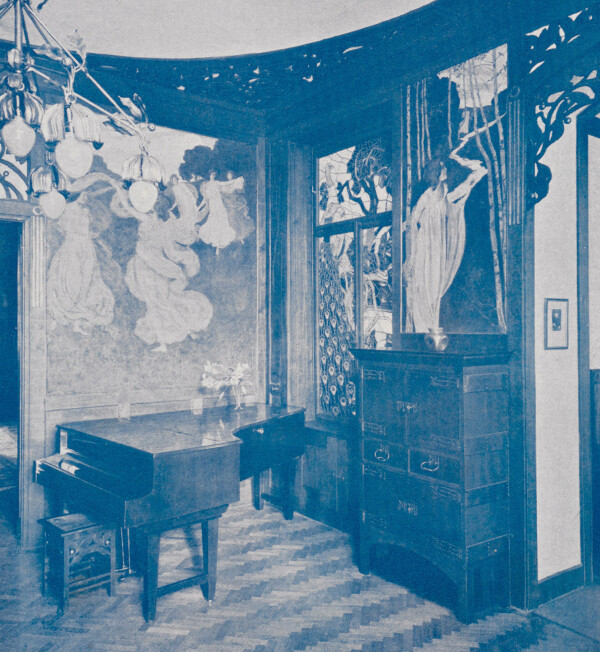
Music room in the house of Georg Adam Scheid, around 1901, in: Vereinigung bildender KünstlerInnen Wiener Secession (Hg.): Ver Sacrum. Mitteilungen der Vereinigung bildender Künstler Österreichs, 4. Jg., Heft 8 (1901).
© ANNO | Austrian National Library
The painter and graphic artist Josef Maria Auchentaller lived mostly in Vienna and from 1903 also in the Adriatic coastal town of Grado. He worked as a portraitist, landscape painter and designer of jewelry and arts-and-crafts objects. His most important achievements, however, were his contributions to the Vienna Secession, the magazine Ver Sacrum and the poster art of Jugendstil.
Josef Maria Auchentaller was born in Vienna on 2 August 1865 and attended the Construction Class at the Technical University from 1882, studying with Karl Lützow and Josef Bayer. He discontinued his studies and instead enrolled in Franz Rumpler’s painting class at the Vienna Academy of Fine Arts in 1886, winning several awards. He completed his military service in 1890 and joined the specialist class of Leopold Carl Müller. He had met Emma Scheid, daughter of the silver and jewelry manufacturer Georg Adam Scheid, as early as 1885 and married her in 1891.
Munich, Italy and the Vienna Secession
Auchentaller moved to Munich in 1892, where he attended Paul Höcker’s painting class at the Royal Bavarian Academy. Here, he established ties to the Munich Secession and contributed to their magazine Jugend. During his years in Munich, he dedicated much of his time to music and literature. Franz Stuck’s Symbolist style of painting also had a major influence on his later work.
Auchentaller and his family traveled through Italy in 1896, with an extended sojourn in Rome. They returned to Vienna in the summer of 1897. Auchentaller now received many commissions from the company of his father-in-law, designing jewelry and arts-and-crafts objects. He also worked as a graphic artist and poster artist and produced graphic contributions to Ver Sacrum, the magazine of the Vienna Secession, from 1898. He finally became a full member of the association in 1899 and was soon appointed a member of the editorial committee and the operating committee. He was solely responsible for the 8th issue of Ver Sacrum in 1901, the magazine’s fourth year. This issue presented designs for textiles, jewelry, arts-and-crafts objects, illustrations and a photography of the music room of Georg Adam Scheid, showcasing Auchentaller’s full artistic range. For the music room at the villa of his in-laws in Vienna’s noble Cottageviertel neighborhood, Auchentaller had created the decorations and a cycle of paintings with Beethoven’s Symphony No. 6, the Pastoral Symphony, as their main theme.
Auchentaller also participated in many exhibitions and contributed to many interior decorations. In 1901, he organized the participation of the Secession in the “VIII. Internationale Kunstausstellung im königlichen Glaspalast zu München” [“8th International Art Exhibition at the Royal Crystal Palace in Munich”]. He was in charge of setting up the rooms and arranging the works, which included Klimt’s Faculty Painting Medicine (1900–1907, destroyed by fire at Immendorf Castle in 1945). In 1902, the momentous “XIV. Beethovenausstellung” [“14th Beethoven Exhibition”] was held at the Vienna Secession as a testimony to the Secessionist aim of the Gesamtkunstwerk. Klimt’s famous Beethoven Frieze was exhibited in the hall to the left and Auchentaller’s Ode to Joy frieze was presented on the longitudinal wall of the hall to the right.
Auchentaller also created designs for the Wiener Werkstätte and the textile company Joh. Backhausen & Söhne. He worked as a commercial artist, advertising bicycles produced by Styria and malted cereal coffee produced by Kathreiner. He painted many portraits, e.g. that of Maria Ast, the wife of the building contractor and art collector Eduard Ast.
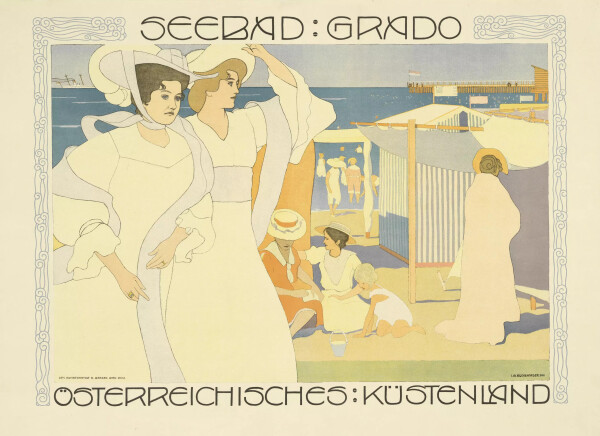
Josef Maria Auchentaller: Poster seaside resort Grado. Austrian coastal country, 1906, Wien Museum
© Wien Museum
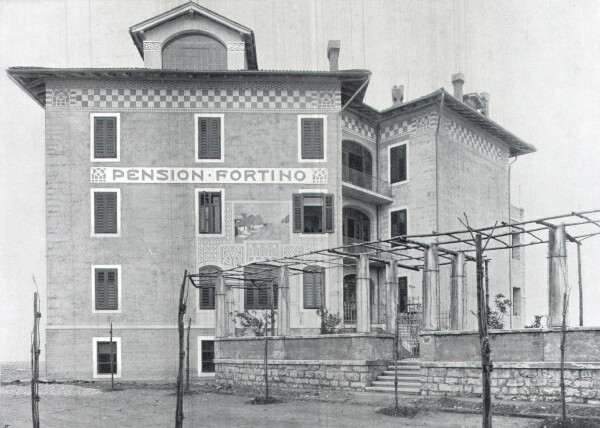
Julius Mayreder: Pension Fortino in the seaside resort of Grado, around 1906, in: Der Architekt. Wiener Monatshefte für Bau- und Raumkunst, 12. Jg. (1906).
© ANNO | Austrian National Library
Grado. Central Europe’s Seaside Resort
In order to contribute to the household budget, Emma Auchentaller decided to open the guesthouse Pension Fortino in Grado with the support of the Marchesini family. The construction of the building, designed by the architect Julius Mayreder, began in 1902. In 1903, the Auchentallers moved to Grado, where they played a key role in the touristic development of the Adriatic seaside resort: Emma managed the guesthouse, which had opened in 1904, and Josef Maria Auchentaller created the iconic poster Seebad Grado. Österreichisches Küstenland [Grado Seaside Resort. Austrian Littoral] as well as further commercial graphics. He now spent his summers in Grado and his winters in Vienna. This weakened his ties to Vienna’s art scene, even though some of his artist friends, including Carl Moll, Alfred Roller and Otto Wagner, would occasionally visit him on the Adriatic Sea.
In 1905, Auchentaller left the Secession together with the Klimt Group. In the following years, he rented a studio in Vienna in 1908, where he gave private painting lessons, participated in several exhibitions – including the “Internationale Kunstschau Wien 1909”, the “I. Internationale Jagdausstellung” [“First International Hunting Exhibition,” 1910] and the “Große Kunstausstellung in Dresden” [“Great Art Exhibition in Dresden,” 1912] – and turned to landscape and portrait painting. His life-long friendship with his sister-in-law Martha (née Scheid) and her husband Viktor Thonet, executive of the eponymous furniture manufacturer, resulted in several portraits of family members.
With the death of their daughter in 1914 and the onset of World War I, a difficult time began for the Auchentallers, who were forced to leave Grado and to flee to the Friulian hinterland. After sojourns in Hinterstoder in Upper Austria and on the Grundlsee, a lake in Styria, Auchentaller was conscripted for military service in 1916. He returned to the Grundlsee in 1917, where he began an intense exploration of landscape painting. In 1919, the couple moved back to Grado. Auchentaller retreated from the art scene in the 1920s and died in Mödling on 30 May 1949.
Literature and sources
- Wien Geschichte Wiki. Joseph Maria Auchentaller. www.geschichtewiki.wien.gv.at/Joseph_Maria_Auchentaller (05/19/2020).
- Österreichisches Biographisches Lexikon. Joseph Maria Auchentaller. www.biographien.ac.at/oebl/oebl_A/Auchentaller_Josef-Maria_1865_1949.xml (05/19/2020).
- Roberto Festi (Hg.): Wiener Bijoux. Gioielli e design / Schmuck und Design. Josef Maria Auchentaller per / für Georg Adam Scheid, Ausst.-Kat., Casa della Musica (Grado), 21.06.2015–01.11.2015, Grado 2015.
- Roberto Festi (Hg.): Josef Maria Auchentaller. 1865-1949. Ein Künstler der Wiener Secession / Un secessionista ai confini dell'Impero, Ausst.-Kat., Palazzo Attems - Petzenstein (Gorizia), 24.04.2008–30.09.2008; Galleria Civica (Bolzano), 25.10.2008–25.01.2009; Leopold Museum (Vienna), 11.06.2009–21.09.2009, Civezzano 2008.
- Vereinigung bildender KünstlerInnen Wiener Secession (Hg.): Ver Sacrum. Mitteilungen der Vereinigung bildender Künstler Österreichs, 4. Jg., Heft 8 (1901).
- Vereinigung bildender Künstler Österreichs Secession (Hg.): Erster Jahresbericht der Vereinigung bildender Künstler Österreichs Secession, Vienna 1899, S. 30.
- Vereinigung bildender Künstler Österreichs Secession (Hg.): Dritter Jahresbericht der Vereinigung bildender Künstler Österreichs Secession, Vienna 1901, S. 9.
- Münchener Künstlergenossenschaft (Hg.): VIII. Internationale Kunstausstellung im königlichen Glaspalast zu München 1901. Illustrirter Katalog, Ausst.-Kat., Glass Palace in Munich (Munich), 01.06.1901–31.10.1901, Munich 1901, S. 11.
- Fritz Novotny, Johannes Dobai (Hg.): Gustav Klimt, Salzburg 1967, S. 389.
- Andreas Maleta: J. M. Auchentallers Beethoven-Musikzimmer.. Die Entdeckung eines Wiener Gesamtkunstwerkes: Vom Musikzimmer zum Beethoven-Fries in der Secession, Vienna 2017.

